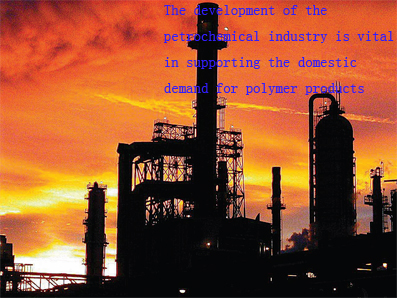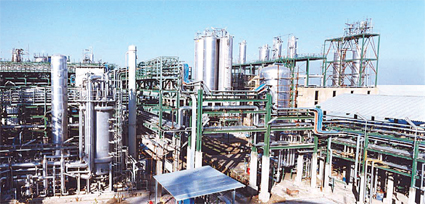
The petrochemical industry of Iran is gaining momentum. Petrochemical production reached 26.5 million tonnes in 2009, a substantial 69% over 2008. Exports rose dramatically to 10.6 million tonnes in 2009 with value hitting $8.2 billion in 2008/2009 as compared to $3.2 billion four years ago. While the figure may be below the target set by Iran's Petrochemical Commercial Company (IPCC), the country's position as a leading supplier has been sealed as it now accounts for at least 25.3% of Middle East petrochemical production in 2008. Taking the industry a step further, the government launched an important blueprint for growth in the petrochemical sector. The 2025 Vision is expected to put the country as a leading petrochemical producer in the region as it aims for 34% market share. To realise this, Iran plans to invest about $100 billion in the oil, gas and downstream industries from 2009 - 2013. The construction of 46 new petrochemical complexes in the 2010/11 Iranian year will add another 50 million tonnes per annum (tpa) to petrochemicals capacity.

To date, six large petrochemical projects worth about $2 billion have been put on stream in Assaluyeh, Bushehr Province. These projects will add about 3.14 million tonnes to the total capacity. These projects include the methanol unit of the second phase of Zagros Petrochemical Complex with annual production capacity of 1.650 million tonnes. The special petrochemicals export terminal of Pars Special Economic Energy Zone (PSEEZ) has a shipment capacity of 35 million tonnes annually and is the second biggest project after Zagros. The other projects include the butadiene unit of Jam Petrochemical Complex with capacity of 245,000 tonnes, Mobin Petrochemical Complex's industrial wastewater treatment facility and air separation facility, and the ethylbenzene and styrene monomer production facilities of Pars Petrochemical Complex with output capacity of 1.245 million tonnes. The development of the petrochemical industry is vital in supporting domestic demand. The Oil Ministry's target is to raise production of ethylene and polymer. By end- 2014, ethylene capacity is expected to reach 7.88 million tpa with other capacities, including 7.06 million tpa PE and 1.29 million tpa PP. LDPE is seen to contribute nearly half of the 3.7 million tpa increase in the PE sector, with HDPE at 33% and LLDPE at 24%. (the finished)

D8: Foundation for stronger cooperation At the recent developing eight countries (D-8) meeting, Iran has pledged to contribute €50 million ($60 million) for the creation of an investment fund for the organisation, being the first country to make such commitment. The conference was attended by 400 domestic and foreign guests.

D-8 is composed of Iran, Bangladesh, Egypt, Indonesia, Malaysia, Nigeria, Pakistan and Turkey. The organisation aims to improve developing countries' positions in the global economy by creating new opportunities for the expansion of trade relations, and improving the standards of living of the people in these countries. There are about 930 million people living in D-8 countries, thus creating a huge market. Trade among member countries reached as much as $68 billion, with transactions among members to increase to about 10-15% in the next few years. As sidelines to the D-8 meeting, Iran also held an exhibition to present its industrial capabilities in the areas of electronics, automotives, textiles, petrochemicals, non-ferrous minerals, foodstuff, healthcare, and agricultural products. The D8 meeting in Tehran also targets to increase business and trade relations by harmonising the customs procedures and creating joint research centres for the sharing of technical expertise for the benefit of all members. Partic
Buty sportowe Nike The petrochemical industry of Iran is gaining momentum. Petrochemical production reached 26.5 million tonnes in 2009, a substantial 69% over 2008. Exports rose dramatically to 10.6 million tonnes in 2009 with value hitting $8.2 billion in 2008/2009 as compared to $3.2 billion four years ago. While the figure may be below the target set by Iran's Petrochemical Commercial Company (IPCC), the country's position as a leading supplier has been sealed as it now accounts for at least 25.3% of Middle East petrochemical production in 2008. Taking the industry a step further, the government launched an important blueprint for growth in the petrochemical sector. The 2025 Vision is expected to put the country as a leading petrochemical producer in the region as it aims for 34% market share. To realise this, Iran plans to invest about $100 billion in the oil, gas and downstream industries from 2009 - 2013. The construction of 46 new petrochemical complexes in the 2010/11 Iranian year will add another 50 million tonnes per annum (tpa) to petrochemicals capacity.
The petrochemical industry of Iran is gaining momentum. Petrochemical production reached 26.5 million tonnes in 2009, a substantial 69% over 2008. Exports rose dramatically to 10.6 million tonnes in 2009 with value hitting $8.2 billion in 2008/2009 as compared to $3.2 billion four years ago. While the figure may be below the target set by Iran's Petrochemical Commercial Company (IPCC), the country's position as a leading supplier has been sealed as it now accounts for at least 25.3% of Middle East petrochemical production in 2008. Taking the industry a step further, the government launched an important blueprint for growth in the petrochemical sector. The 2025 Vision is expected to put the country as a leading petrochemical producer in the region as it aims for 34% market share. To realise this, Iran plans to invest about $100 billion in the oil, gas and downstream industries from 2009 - 2013. The construction of 46 new petrochemical complexes in the 2010/11 Iranian year will add another 50 million tonnes per annum (tpa) to petrochemicals capacity.  To date, six large petrochemical projects worth about $2 billion have been put on stream in Assaluyeh, Bushehr Province. These projects will add about 3.14 million tonnes to the total capacity. These projects include the methanol unit of the second phase of Zagros Petrochemical Complex with annual production capacity of 1.650 million tonnes. The special petrochemicals export terminal of Pars Special Economic Energy Zone (PSEEZ) has a shipment capacity of 35 million tonnes annually and is the second biggest project after Zagros. The other projects include the butadiene unit of Jam Petrochemical Complex with capacity of 245,000 tonnes, Mobin Petrochemical Complex's industrial wastewater treatment facility and air separation facility, and the ethylbenzene and styrene monomer production facilities of Pars Petrochemical Complex with output capacity of 1.245 million tonnes. The development of the petrochemical industry is vital in supporting domestic demand. The Oil Ministry's target is to raise production of ethylene and polymer. By end- 2014, ethylene capacity is expected to reach 7.88 million tpa with other capacities, including 7.06 million tpa PE and 1.29 million tpa PP. LDPE is seen to contribute nearly half of the 3.7 million tpa increase in the PE sector, with HDPE at 33% and LLDPE at 24%. (the finished)
To date, six large petrochemical projects worth about $2 billion have been put on stream in Assaluyeh, Bushehr Province. These projects will add about 3.14 million tonnes to the total capacity. These projects include the methanol unit of the second phase of Zagros Petrochemical Complex with annual production capacity of 1.650 million tonnes. The special petrochemicals export terminal of Pars Special Economic Energy Zone (PSEEZ) has a shipment capacity of 35 million tonnes annually and is the second biggest project after Zagros. The other projects include the butadiene unit of Jam Petrochemical Complex with capacity of 245,000 tonnes, Mobin Petrochemical Complex's industrial wastewater treatment facility and air separation facility, and the ethylbenzene and styrene monomer production facilities of Pars Petrochemical Complex with output capacity of 1.245 million tonnes. The development of the petrochemical industry is vital in supporting domestic demand. The Oil Ministry's target is to raise production of ethylene and polymer. By end- 2014, ethylene capacity is expected to reach 7.88 million tpa with other capacities, including 7.06 million tpa PE and 1.29 million tpa PP. LDPE is seen to contribute nearly half of the 3.7 million tpa increase in the PE sector, with HDPE at 33% and LLDPE at 24%. (the finished)  D8: Foundation for stronger cooperation At the recent developing eight countries (D-8) meeting, Iran has pledged to contribute €50 million ($60 million) for the creation of an investment fund for the organisation, being the first country to make such commitment. The conference was attended by 400 domestic and foreign guests.
D8: Foundation for stronger cooperation At the recent developing eight countries (D-8) meeting, Iran has pledged to contribute €50 million ($60 million) for the creation of an investment fund for the organisation, being the first country to make such commitment. The conference was attended by 400 domestic and foreign guests.  D-8 is composed of Iran, Bangladesh, Egypt, Indonesia, Malaysia, Nigeria, Pakistan and Turkey. The organisation aims to improve developing countries' positions in the global economy by creating new opportunities for the expansion of trade relations, and improving the standards of living of the people in these countries. There are about 930 million people living in D-8 countries, thus creating a huge market. Trade among member countries reached as much as $68 billion, with transactions among members to increase to about 10-15% in the next few years. As sidelines to the D-8 meeting, Iran also held an exhibition to present its industrial capabilities in the areas of electronics, automotives, textiles, petrochemicals, non-ferrous minerals, foodstuff, healthcare, and agricultural products. The D8 meeting in Tehran also targets to increase business and trade relations by harmonising the customs procedures and creating joint research centres for the sharing of technical expertise for the benefit of all members. ParticButy sportowe Nike
D-8 is composed of Iran, Bangladesh, Egypt, Indonesia, Malaysia, Nigeria, Pakistan and Turkey. The organisation aims to improve developing countries' positions in the global economy by creating new opportunities for the expansion of trade relations, and improving the standards of living of the people in these countries. There are about 930 million people living in D-8 countries, thus creating a huge market. Trade among member countries reached as much as $68 billion, with transactions among members to increase to about 10-15% in the next few years. As sidelines to the D-8 meeting, Iran also held an exhibition to present its industrial capabilities in the areas of electronics, automotives, textiles, petrochemicals, non-ferrous minerals, foodstuff, healthcare, and agricultural products. The D8 meeting in Tehran also targets to increase business and trade relations by harmonising the customs procedures and creating joint research centres for the sharing of technical expertise for the benefit of all members. ParticButy sportowe Nike
 iConnectHub
iConnectHub
 Login/Register
Login/Register Supplier Login
Supplier Login


























